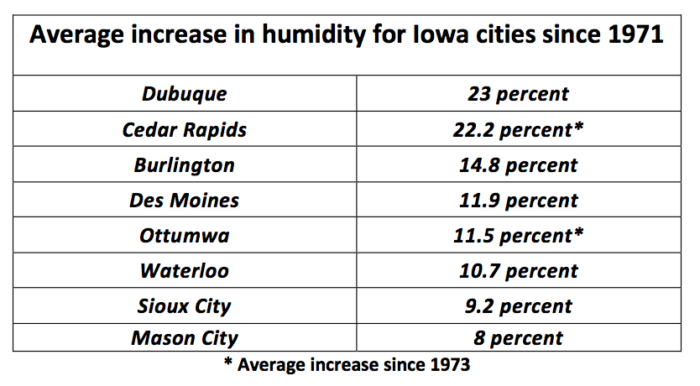“Uncomfortable humidity, water‐logged spring soils, extreme rain events, mold, and mosquitoes are all expected to become more prevalent in Iowa due to a rarely discussed impact of climate change: increased humidity,” 190 scientists at academic institutions warned last week. In the sixth annual Iowa Climate Statement, science faculty and researchers from 39 colleges and universities noted that “Increases in humidity have been measured across the Midwest and in Iowa across all seasons and at all long‐term monitoring stations.”
High levels of humidity create hazardous conditions for Iowa workers and sensitive populations through the danger of heat exhaustion and heatstroke. Allergic rhinitis and asthma are worsened by heightened exposures to mold and dust mite allergens in humid environments. There also is evidence for increased aggression and societal violence associated with hot, humid weather.
For Iowa agriculture, increased warm‐season humidity leads to increased rainfall, extreme rain events, water‐logged soils during planting season, soil erosion, and runoff of chemicals to waterways. Rising humidity also leads to longer dew periods and higher moisture conditions that elevate costs of drying grain and increase populations of many pests and pathogens harmful to both growing plants and stored grain. Increased nighttime temperatures coupled with humidity causes stress to crops, livestock and pets and, in extreme cases, heat stress can cause loss of life.
I enclose below the full text of this year’s Iowa Climate Statement, with references, along with the news release highlighting key findings. You can view the names and academic affiliations all who signed here.
P.S.-The Center for Global & Regional Environmental Research at the University of Iowa, which has coordinated the release of the Climate Impact Statement, is set to lose much of its funding in 2022. This spring, Republican legislators approved and Governor Terry Branstad signed into law a bill eliminating a small tax on investor-owned utilities, which has supported the CGRER and the Iowa Energy Center at Iowa State University for 25 years.
August 9 press release from the Center for Global & Regional Environmental Research at the University of Iowa.
Iowa State Fair time means…It’s not just the heat, it’s the humidity!
Iowa humidity increased by 8% ‐ 23% since 1971
As Iowans head off to enjoy the Iowa State Fair they will notice more than the latest deep fried food delicacy. They might notice increased humidity. That’s because according to Iowa’s leading climate scientists, Iowa has experienced a significant increase in humidity levels since 1971.
“Absolute humidity, which is typically measured by dew point temperature, has increased statewide from 1971 to 2017. Measurements show Dubuque had the largest increase in humidity, a springtime increase of 23%,” said Gene Takle, Director, ISU Climate Science Program, Professor of Geological & Atmospheric Sciences, Department of Agronomy, Iowa State University.
Iowa’s increasing humidity is an important and rarely discussed result of climate change. “Besides making outside activities like visiting the State Fair more uncomfortable, increasing humidity creates conditions favorable for increased rainfall, extreme rain events, mold and mosquitoes in Iowa. Significant Increases in humidity have been measured across all seasons and at all long‐term monitoring stations in Iowa,” said Betsy Stone, Associate Professor, Department of Chemistry, Department of Chemical and Biochemical Engineering, University of Iowa.
The seventh annual statement, “Iowa Climate Statement 2017: It’s not just the heat, it’s the humidity!,” released Tuesday, August 9, was signed by 190 science faculty and researchers from 39 Iowa colleges and universities. The statement describes the impact of significantly higher humidity levels on people, animals, crops and infrastructure.
For the last six years, researchers and educators at nearly every Iowa college and university have produced annual statements on the impact of climate change on Iowans.
”Increased levels of humidity create hazardous conditions for Iowa workers and sensitive populations through the danger of heat exhaustion and heatstroke. Asthma is worsened by higher levels of allergens in the air. And the cost of air conditioning homes and businesses to maintain comfort levels increases,” said Takle, from Iowa State University.
“For Iowa’s agriculture, increased warm‐season humidity leads to water‐logged soils during planting season, rising humidity also leads to longer dew periods and higher moisture conditions that elevate costs of drying grain. Increased nighttime temperatures coupled with humidity causes stress to crops, livestock and pets,” said Takle.



1 Comment
Humidity
Most of my relatives live in regions with higher humidity, and whenever I visit them I am grateful that Iowa is less humid. This is bad news.
PrairieFan Thu 17 Aug 3:48 PM